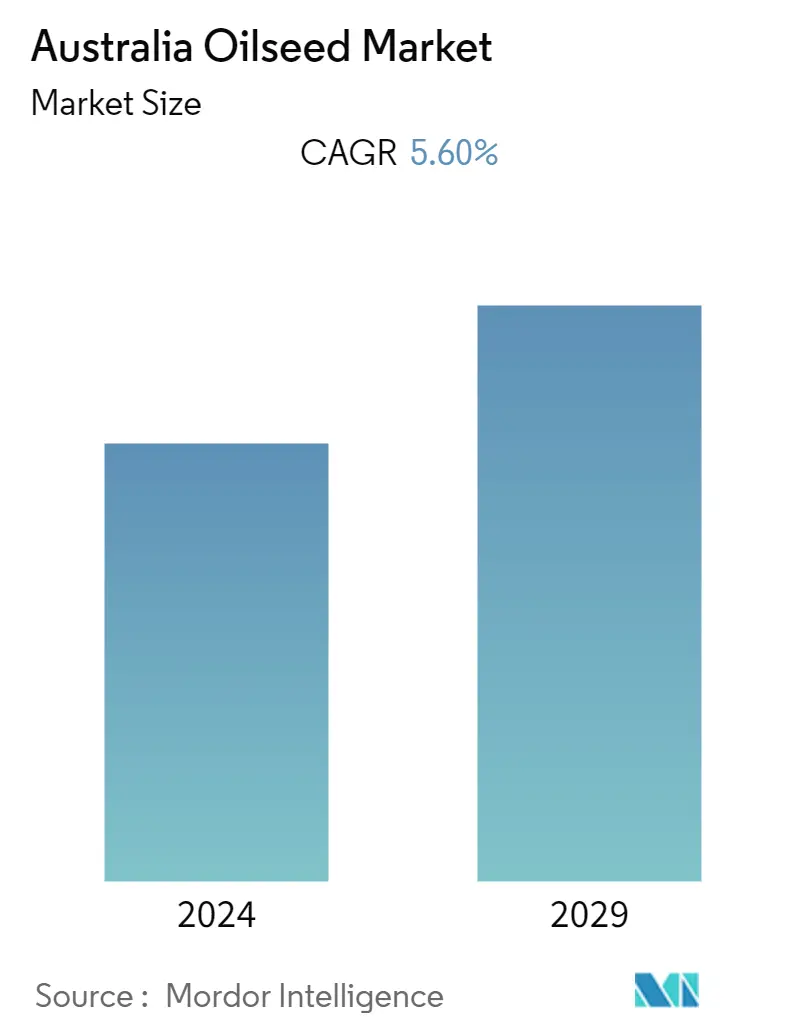Market Size of Australia Oilseed Industry

| Study Period | 2019 - 2029 |
| Base Year For Estimation | 2023 |
| Forecast Data Period | 2024 - 2029 |
| Historical Data Period | 2019 - 2022 |
| CAGR | 5.60 % |
Major Players*Disclaimer: Major Players sorted in no particular order |
Australia Oilseed Market Analysis
The Australian oilseed market is estimated to grow at a CAGR of 5.6%, during the forecast period (2020-2025).
Increased demand for canola oil, driven by a growing health consciousness amongst the consumers, has subsequently led to a surge in the demand for rapeseed for the oil processing sectors across countries. Favorable climatic conditions in the major rapeseed growing regions in western and southern Australia, following years of extreme drought, along with improved domestic and international prices of canola, are helping augment the production of rapeseed in the country, in order to cater to the expanding demand in the importing countries.
Furthermore, government initiatives in developing inter-trade relations with Asia have helped establish the significance of high-quality GM and non-GM oilseeds from Australia in the region. For instance, the Australian Export Grains Innovation Center (AEGIC), along with Grain Trade Australia, has been working towards the development of Australian canola exports for Chinese processing industries. Furthermore, the growth of the Philippine and Malaysian livestock and poultry industries pose a significant opportunity for Australian oilseeds for the feed industries in these countries.
Australia Oilseed Industry Segmentation
The majorly produced oilseeds in Australia, viz., rapeseed, cottonseed, soybean, sunflower seed, and safflower seed, have been considered under the scope of the study. The scope extends to both qualitative and quantitative analyses of the production, consumption, import, and export trends of oilseeds in the country. The review period considered for the study is 2016-2019 and the forecast period is 2020-2025.
| Oilseed Type | |||||||
| |||||||
| |||||||
| |||||||
| |||||||
|
Australia Oilseed Market Size Summary
The Australian oilseed market is poised for significant growth, driven by increasing global demand for canola oil, which is bolstered by rising health consciousness among consumers. This demand has led to a surge in rapeseed production, particularly in western and southern Australia, where favorable climatic conditions have returned after years of drought. The improved domestic and international prices of canola are further supporting this growth, enabling Australia to cater to the expanding needs of importing countries. Government initiatives to strengthen trade relations with Asian countries have also played a crucial role, with organizations like the Australian Export Grains Innovation Center and Grain Trade Australia focusing on enhancing canola exports to Chinese processing industries. Additionally, the burgeoning livestock and poultry sectors in the Philippines and Malaysia present lucrative opportunities for Australian oilseeds in the feed industry.
Australia's strategic position as a leading oilseed producer is underscored by its substantial share in global canola trade. Despite challenges posed by climatic disruptions, Australian oilseeds are gaining traction in Asian markets, supported by inter-trade development activities such as the Japan-Australia Economic Partnership Agreement. This has increased the demand for Australian high-quality GM and non-GM grains and oilseeds, particularly in Japan. The Chinese government's restrictions on Canadian canola imports have opened up opportunities for Australian rapeseed exports to China, although the African Swine Fever outbreak has impacted soybean trade. Projections indicate a rise in canola production, which is expected to bolster the market for non-GM canola in Europe. These dynamics are anticipated to drive the growth of the oilseed market in Australia over the forecast period.
Australia Oilseed Market Size - Table of Contents
-
1. MARKET DYNAMICS
-
1.1 Market Overview
-
1.2 Market Drivers
-
1.3 Market Restraints
-
1.4 Value Chain Analysis
-
1.5 PESTLE Analysis
-
-
2. MARKET SEGMENTATION
-
2.1 Oilseed Type
-
2.1.1 Rapeseed
-
2.1.1.1 Production Analysis
-
2.1.1.2 Consumption Analysis & Market Size
-
2.1.1.3 Import Market Analysis (Volume & Value)
-
2.1.1.4 Export Market Analysis (Volume & Value)
-
2.1.1.5 Price Trend Analysis
-
-
2.1.2 Cotton seed
-
2.1.2.1 Production Analysis
-
2.1.2.2 Consumption Analysis & Market Size
-
2.1.2.3 Import Market Analysis (Volume & Value)
-
2.1.2.4 Export Market Analysis (Volume & Value)
-
2.1.2.5 Price Trend Analysis
-
-
2.1.3 Soybean
-
2.1.3.1 Production Analysis
-
2.1.3.2 Consumption Analysis & Market Size
-
2.1.3.3 Import Market Analysis (Volume & Value)
-
2.1.3.4 Export Market Analysis (Volume & Value)
-
2.1.3.5 Price Trend Analysis
-
-
2.1.4 Sunflower Seed
-
2.1.4.1 Production Analysis
-
2.1.4.2 Consumption Analysis & Market Size
-
2.1.4.3 Import Market Analysis (Volume & Value)
-
2.1.4.4 Export Market Analysis (Volume & Value)
-
2.1.4.5 Price Trend Analysis
-
-
2.1.5 Safflower Seed
-
2.1.5.1 Production Analysis
-
2.1.5.2 Consumption Analysis & Market Size
-
2.1.5.3 Import Market Analysis (Volume & Value)
-
2.1.5.4 Export Market Analysis (Volume & Value)
-
2.1.5.5 Price Trend Analysis
-
-
-
Australia Oilseed Market Size FAQs
What is the current Australia Oilseed Market size?
The Australia Oilseed Market is projected to register a CAGR of 5.60% during the forecast period (2024-2029)
What years does this Australia Oilseed Market cover?
The report covers the Australia Oilseed Market historical market size for years: 2019, 2020, 2021, 2022 and 2023. The report also forecasts the Australia Oilseed Market size for years: 2024, 2025, 2026, 2027, 2028 and 2029.

